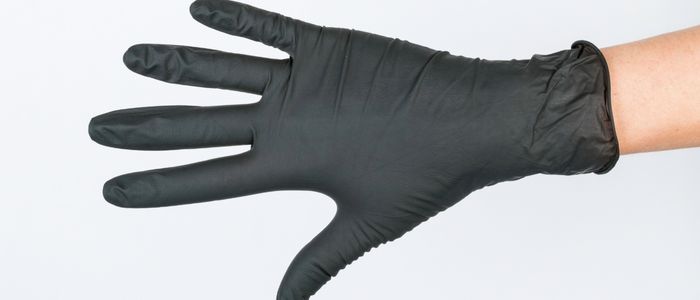Are you searching for what the difference is between nitrile, latex, and vinyl Gloves? Then you’ve probably come across the right place! We’ll talk about these 3 types of disposable gloves!
What are Disposable Gloves?
Disposable gloves are essential in any healthcare setting. Disposable gloves are essential for healthcare professionals and patients to protect them from potential microbes. They also set the standard of hygiene and care in the industry. This shouldn’t surprise you, but disposable gloves are not all created equally.
Certain products are better suited to different medical environments because of their design and materials. You could end up wasting resources, increasing the risk for punctures, rips and tears, and possibly even wasting your money if you choose the wrong glove.
Disposable gloves can be made from one of three materials: vinyl, latex or nitrile. We’ll be discussing the differences between these gloves and providing guidance on which environments each glove is most suitable for.

What is Nitrile?
Nitrile is a sturdy, synthetic rubber exactly known as acrylonitrile-butadiene rubber and was established for a number of reasons, namely, due to the issues surrounding common allergies to latex gloves and the lack of safety against thinners that latex provides. These gloves were originally introduced in the mid-1990s for medical purposes, but they have become very popular with industrial and laboratory customers.
- Nitrile gloves have very low allergic rates and are free of latex. These gloves are very popular because of their versatility (can be used across many industries), low allergy rates and cost. Although nitrile gloves used to be more expensive than latex, their popularity has increased and they now cost about the same as latex gloves.
- Nitrile is more resilient to substances compared to latex. This is a major advantage of a Nitrile glove, and it is especially important when the user is in contact with dangerous substances.
- One of the many benefits of nitrile gloves is its tendency to tear when punctured. This makes it easy to identify if the glove is compromised. A latex glove, on the other hand, will not be damaged and can be overlooked if it has a small puncture. This is the main advantage of a Nitrile glove over a Latex glove for handling hazardous substances. It is important to inspect your glove for punctures before using it with hazardous substances. Although the Nitrile tear feature can be an advantage, it is not an effective preventative measure.

What is Latex?
Latex gloves, made from rubber, are the traditional glove. They have been around for many years. There are some allergy concerns about latex gloves. However, users often prefer them to a nitrile glove due to their strength and comfort. Latex gloves are more comfortable and sensitive. They also provide better grip. However, nitrile gloves have become thinner, more comfortable and more dexterous thanks to modern manufacturing techniques.
- Latex gloves are a concern. This is because of the allergic reaction people have to latex. Although allergies to latex can not be life-threatening, they can cause discomfort. Most people experience a mild to severe skin reaction within hours of exposure. Rarely, an even more severe reaction can occur such as an anaphylactic attack that could lead to death. Recurrent exposure can make allergic reactions more severe, which is also cause for concern. Even if you are not allergic to latex, you should be aware that gloves can cause allergic reactions in people who come into contact with them.
- While latex gloves offer exceptional physical barrier performance, they are not as effective against solvents as nitrile. Nitrile is a better option if you are looking for chemical resistance.

Vinyl Gloves
Vinyl gloves are also very popular, but they are not recommended for use in all environments. Vinyl gloves are the least expensive of all three materials and are free from latex. Vinyl gloves are used in high-volume environments when working with non-hazardous materials. They offer minimal protection. Vinyl gloves are looser fitting than latex or nitrile gloves and therefore more uncomfortable to wear. Vinyl gloves are usually worn for only a few minutes.
- Vinyl gloves are not recommended for use in environments where hazardous substances may be present. They have low resistance against many chemicals. Vinyl gloves are normally used in the food and beverage businesses. They are suitable for tasks that are low-risk and last for a brief time.
- Vinyl gloves can cause no allergic reaction and are rarely reported to be causing any. Although some people complain about an allergic reaction to wearing vinyl gloves, it is really a skin irritation caused by the lack of ventilation. Because the glove traps heat and sweat, the hand will feel hot and itchy.
- Nitrile has been the most widely used choice of gloves in most industries over recent years. The nitrile material is chemical resistant and eliminates common allergic factors. Decide which glove is best for you. Consider how much protection you need. Do I need to take into account possible allergies?

The 3 Main Differences Between Nitrile, Latex And Vinyl Gloves are as follows:
Materials
- Latex is the most widely used glove material. It is biodegradable and made from organic tree sap. This makes it 100% natural. An allergy to natural rubber proteins is a common reaction that can develop from latex products. This allergy can cause irritation and, in severe cases, respiratory problems. People with a latex allergy will prefer vinyl or nitrile gloves.
- Nitrile, a synthetic rubber similar to latex made from natural rubber (nitrile butadiene) Nitrile gloves are latex-free, which means that they have very low allergy rates (less than 1%).
- Vinyl gloves can also be made entirely synthetic and are free of latex. They are made from PVC (petroleum-based plastic). Vinyl gloves are almost as safe as Nitrile gloves in that allergic reactions are virtually non-existent.
Protection/ Uses
- The best protection against bacteria, viruses, and body fluids is provided by latex gloves. They are popular among those working in the medical and food industries. However, they don’t offer any protection against solvents so nitrile is a better option.
- The best glove for puncture resistance is Nitrile gloves, also known as medical grade. They can provide 3x more puncture and tear resistance than latex gloves. Although a similar material to latex, nitrile has a more durable feel and fit than latex. It is also resistant to solvents and oils, which makes it ideal for medical applications, labs, meat processing and the chemical industry. Because they can withstand higher temperatures than latex, nitrile gloves are a popular choice for automotive applications.
- Vinyl gloves are not designed to protect against biomedical or chemical exposure. They are therefore often used in low-infection and non-hazardous environments such as the food industry, and other situations where durability and protection are less important. Vinyl gloves are compliant with EC 1935/2004, and European Regulation 10/2011. However, they shouldn’t be used for handling fatty foods as oils can leach into the food, making the glove brittle.

Fit
- Latex gloves can be worn for extended periods of time because they are very close fitting, much like second skin. The high degree of sensitivity offered by latex gloves is another advantage. They can also be easily put on because they are lightly powdered.
- Nitrile gloves have a less snug fit to the hand than latex gloves. This permits for a better range of gesture. They are more comfortable than latex gloves and can be worn for longer periods of time.
- Vinyl gloves are much more flexible than latex or nitrile gloves. Vinyl gloves are often worn for short periods of times because they have a looser fit than latex and nitrile gloves.
These key differences will assist you in making the best choice when choosing exam gloves for your unique medical environment. Hebei Shouzheng offers a variety of disposable latex and nitrile gloves to suit a variety of needs and uses. Hebei Shouzheng’s gloves offer the strength and protection required to outsmart infection.
Which Disposable Glove Material is Right for You?
The application of the glove, irritation and price are all features that should be considered when picking the right glove. The glove should be the right size for you. This will guarantee that the gloves are relaxed and won’t slip off your hands.
Some people have reported allergic reactions to the cornstarch powder used in powdered or lightly powdered gloves. This could show a role in choosing powdered gloves or those that are powder-free.
For any questions or to request a quote, send us a message. Within 24 hours, our experts will reply and help you choose the right medical products.

